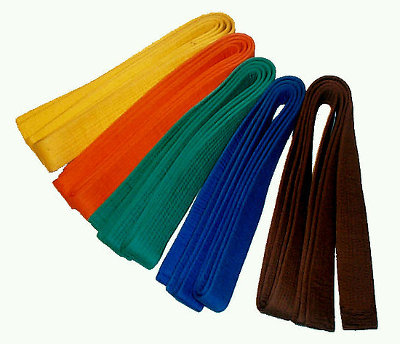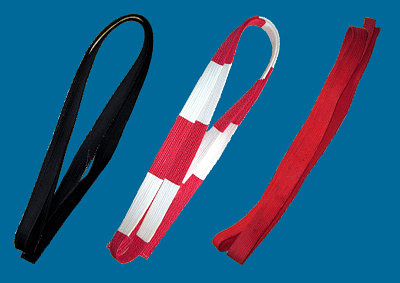About the Use of Belt Colours in Karate
(by Marc Janott, April 2015)
The examination was successful. So let's go and get a new belt. - With that new colour around our waist we go back to training. - "Looks good on you. Congratulations!"
But why do we actually need a new belt in another colour? Didn't the old belt hold the jacket together just as well?
Belt colours in Karate can have
- organisational,
- psychological and
- social
meaning. So let's take a closer look at those three aspects.
Organisational

In Karate we can all train together, everybody at their individual level of skill. In training it often happens that an instructor will give more complex tasks to the experienced people and less complex tasks to beginners. Belt colours then facilitate assigning the tasks: "Everybody from white to green please do A. Blue and brown do B. Black do C."
In this scenario, dividing the group by belt colours is much easier than using kyu grades. For most people "everybody from white to green" is much easier to comprehend than "everybody from 9th to 6th kyu."
Grouping by colour is especially useful when dealing with larger numbers of participants. If the group consists of just half a dozen people, we can address each one of them by name. If all participants are at about the same skill level, or if they're all supposed to do the same anyway (e.g. when warming up), then there is no need for belt colours at all.
Psychological
Another reason for belt colours is motivation. Working to earn the right to wear the next belt can be a helpful incentive for training. The coloured belt around your waist is testimony of your skill level to the people around you. Children are particularly motivated - well, sometimes it's their parents who are rather than the kids.
On the other hand, the desire for the next belt colour can also distract from the development of technique and understanding. Setting your objective as "I want to achieve my blue belt in summer" is very different from "I want to improve my hip rotation and breathing technique until summer". It is similar to the desire to own a car as opposed to actually learning to drive.
Then again, the belt colour does reflect back onto the person wearing it: It feels different to wear the new colour. When we take the belt out of our bag and put it on, it reminds us of our last grading examination, and of the acknowledgement of our personal progress. Likewise, it reminds us of the greater responsibility we have as more experienced karatekas. Last but not least, we have a mental image of a certain level of skill associated with each belt colour, and we will aspire to perform in training at a level that's commonly expected of a karateka with our belt colour.
Our skills or weaknesses are not changed by the colour of our belt, of course. However, it would seem that the expectations raised by ourselves or others will motivate us to measure up to these expectations. Because the belt colour displays a certain standard within our group, we will try to act by this expected standard and work with the appropriate discipline in training.
Social
The right to wear a belt colour is normally earned through a grading examination. The colour shows that the examiners have acknowledged your skills. In that way it therefore also signifies a social relationship - the relationship with your examiners.

Higher dan grades are sometimes awarded to by karate associations. In this case the karateka would not take a test, instead the association awards the dan grade as an honourable degree for long-standing commitment to the association or similar reasons (much like a badge of honour).
A special belt with alternating red and white colours has been introduced for distinguished masters. Beyond that there is the pure red belt for outstanding masters. Those belts are meant for special occasions. In everyday training however, the honourable masters would usually wear a black belt.
Of course wearing belt colours makes sense only when there are people around to actually see them. Only in a social context do the colours convey their meaning.
The superficial distinction of karatekas by their belt colours essentially contradicts the idea of the white karate uniform that signifies a community of equals. So in the dojo (training hall) for example, we can sometimes see the formation of small groups. The black and brown belts stand together, the white to green belts stand together, and the blue belts are a bit uncertain about which group they belong to. To a beginner it can feel intimidating to face a bunch of black belts. He/she might be reluctant to approach them because of some unnessesary sense of awe. It therefore is the responsibility of the senior karatekas to walk over to the beginners and start a conversation.
Aside from awe, belt colours can also induce envy and strife. "How could that guy make it to blue belt? He's useless." or "Why is she still an orange belt? She is at least at blue belt level." Such thoughts and comments result from the superficial display of the respective grades. If everybody wore the same belt colour, people would appreciate each other's skills rather than rank.
Conclusion
Belt colours make sense in larger groups (clubs, seminars, associations). They are useful to instructors when structuring training, and they can help motivate students. Furthermore, they do have an effect on the behaviour of the person wearing it. Beginners can easily recognise senior students who possibly can answer questions the beginner might have. Belt colours reflect the appreciation of commitment within the social context - be it technical skill or recognised work within an association. Just like other status symbols, belt colours can induce the formation of small groups or even jealousy. It is the duty of the more experienced karatekas to uphold the positive meaning of belt colours and by their responsible demeanour prevent negative effects.
Recommended external articles:
